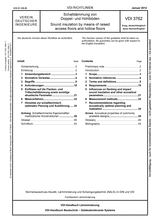
Technical rule [CURRENT]
VDI 3762:2012-01
Sound insulation by means of raised access floors and hollow floors
- German title
- Schalldämmung von Doppel- und Hohlböden
- Publication date
- 2012-01
- Original language
- German, English
- Pages
- 46
- Publication date
- 2012-01
- Original language
- German, English
- Pages
- 46
Product information on this site:
Quick delivery via download or delivery service
All transactions are encrypted
Short description
Overview
Raised access floors and hollow floors are sophisticated technical structures with various and complex requirements; their acoustical evaluation and testing requires specific knowledge and experience. This guideline aims at presenting principal parameters of influence and the structural characteristics of raised access floors and hollow floors which affect the horizontal air-borne and impact sound transmission between rooms, as well as the improvement of impact sound insulation of ceilings for the vertical direction. Moreover, it deals with effects of such floors on room acoustics and fundamental correlations as far as footfall noises. Furthermore, there is a description and outline of how required acoustical characteristics of raised access floors and hollow floors can be determined taking into account the other flanking building elements and structures have to be designed to meet specified acoustical requirements. When the sound insulation between rooms is to be determined, the acoustical properties of the floor as well as those of the flanking elements have to be known. This guideline is therefore part of a variety of rules considered necessary for this case, such as DIN 4109, VDI 4100 and the standard series DIN EN ISO 10140. This guideline is directed at manufacturers of raised access and hollow floor systems, as well as at companies specialized in installing such systems, at architects and engineers, manufacturers and suppliers of insulating materials and other accessories, building owners, authorities, and experts in acoustics. No substantial changes have been made with respect to the November 1998 version of this guideline. However, the current state of the art and of standardization has been taken into account in the terminologies of construction and acoustics, as well as for the measurement methods. This guideline has been prepared at the Acoustics, Noise Control and Vibration Engineering Standards Committee (NALS) by Working Committee NA 001-02-03-16 AK "Überarbeitung VDI 3762" ("Revision of VDI 3762") and tested by parent committee NA 001-02-03 AA "Schallausbreitung und Lärmminderung in Gebäuden, in Arbeitsstätten und im Freien" ("Sound propagation and noise control in buildings and workplaces, and outdoors") and adopted as a guideline.
Content
ICS
This document replaces VDI 3762:1998-11 .

